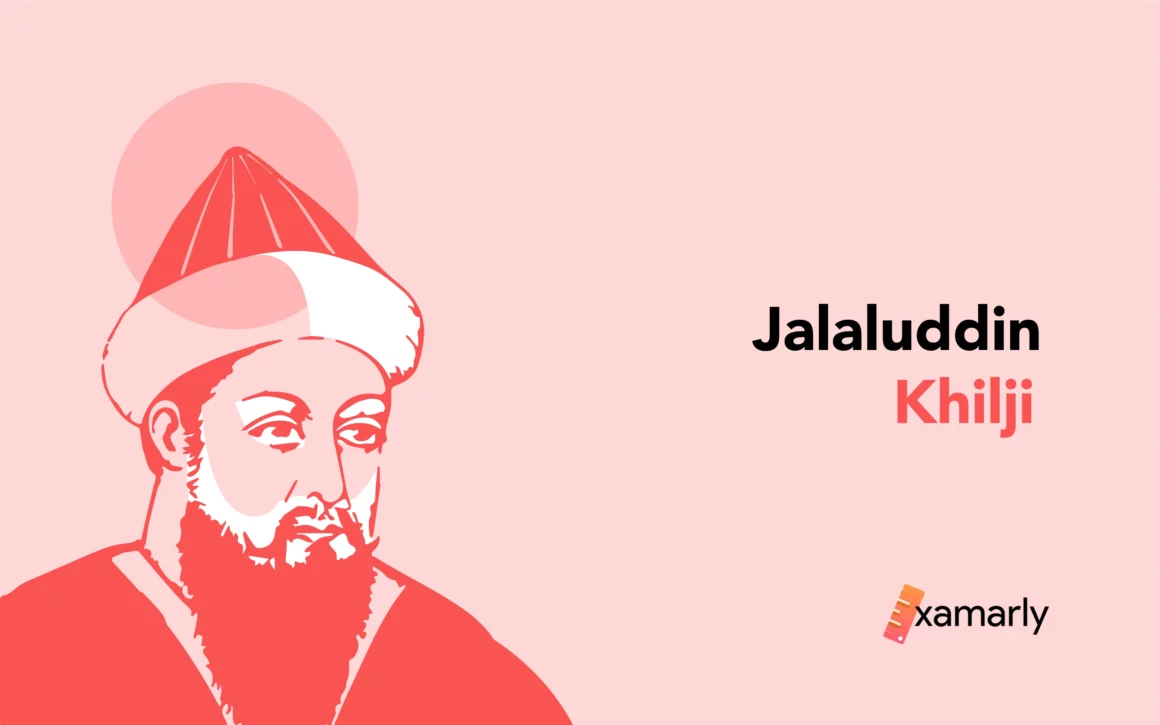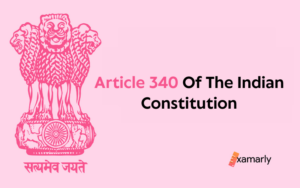Jalaluddin Khilji (1290-1296 AD) was the founder and first sultan of the Khilji Dynasty. At the age of 70, in 1290 AD, he sit on the throne and ruled the empire of Delhi under Khilji Dynasty.
Jalal-ud-din, who was originally known as Firuz, began his career as a Mamluk dynasty official and later attained prominence under Sultan Muizzuddin Qaiqabad. A gang of nobles attempted to assassinate Jalal-ud-din when Qaiqabad became crippled and named his young son Shamsuddin Kayumars as the new Sultan. Jalal-ud-din, who ended up becoming the regent, had them executed instead. He overthrew Kayumars and took over as Sultan.
Continue reading to gain a deeper understanding of this exceptional figure. This will be helpful for your UPSC preparation. This is a part of theUPSC Syllabus covered under the section of Medieval Indian History.
Early Life Of Jalaluddin Khilji
Jalaluddin Firuz Khilji belonged to the Turkic Khalaj tribe, which had been in Afghanistan for more than 200 years after migrating from Turkistan. Under Sultan Muizzuddin Qaiqabad, he rose to the rank of Sar-I-Jandar. He later served as the Samana frontier province’s governor. Following the paralysis of Qaiqabad, several nobles designated Shamsuddin Kayumars, as the new Sultan.
In 1287, Delhi Kotawal Malik al-Umara Fakhruddin nominated young Muiz ud din Qaiqabad, a grandson of Ghiyas Ud Din Balban, as ruler. Later given the title Muizzuddin. As a result of Qaiqabad’s weakness, his officer Malik Nizamuddin actually oversaw the administration. Following the poisoning of Nizamuddin by some rival officers, Qaiqabad contacted Jalal-ud-din Khilji from Samana to Delhi. He bestowed the title of “Shaista Khan” to Jalal-ud-din Khilji and designated him Ariz-i-malik before being named governor of Baran.
Learners can learn more about Muiz ud Din Qaiqabad, a 10th Sultan of the Slave Dynasty, through the linked article.
Ascending To The Throne
In June 1290, Jalal-ud-din Khilji became the new ruler of the Delhi sultanate. It happened at the incomplete Kilokri Palace in Delhi. Jalal-ud-din was extremely disliked at the point of his ascent. Old Turkish Nobles, who mistakenly thought he was of non-Turkic descent and perceived him as an Afghan did not support him much.
Because of his lack of popularity, he decided against relocating to Balban’s palace in Delhi. Instead spent about a year living at Kilokhri, turning it into a viable town. Jalal-ud-din kept the old Turkic Nobles in office and didn’t make any significant changes to the way the government was run.
For instance, Balban’s nephew Malik Chajju was kept on as the governor of Kara-Manikpur, while Fakhruddin was kept on as the kotwal of Delhi and Khwaja Khatir was kept on as the wazir. Likewise, Jalal-ud-din selected his family members and friends for significant positions. This includes the appointment of his brother Yaghrash Khan as the head of the army ministry, the title Khan-i-Khan to his eldest son Mahmud and the next two sons were given the titles Arkali Khan and Qadr Khan.
Jalal-ud-din subdued the early Delhi uprising by demonstrating his worth. He developed a solid reputation as a respectful, kind, and polite ruler. He refused to sit in the king’s seat saying that the crown was forced upon him. It was done so with Kachhan and Gurkha’s ill intentions in the royal audience hall. The kindness and selfless deeds of Jala-ud-din helped him win over the resentment of the Delhi residents.
Administrative And Economic Policies
Jalaluddin Khilji had complete control over everything and had strict economic policies and administration. It was difficult and even hopeless for peasants, merchants, and the common man to preserve their positions. In order to increase his budget, fulfill his obligations, and store for his expansionist wars, he just changed the expenditure procedures.
All agricultural products, cattle, and enslaved people were subject to quality requirements. Anyone trying to buy or sell items outside of the permitted range could be caught by a big group of detectives scanning the mandi. Food hoarding by individuals was prohibited. Jalaluddin Khilji established a distribution network. There he only raised agricultural taxes from 20% to 50%, paid in grains and other local goods or in cash, and did away with installments.
Revolt Of Malik Chhajju
Malik Chajju Kashli Khan was Balban’s nephew and the head of the old royal dynasty. He staged a rebellion in August 1290 AD.
After placing his eldest son in charge of Delhi, Jalal-ud-din went out to quell the insurrection. He had the support of several other eastern lords, including the governor of Oudh, Amir Ali Hatim Khan.
The eldest son of Jalal-ud-Din, Arkali Khan, defeated Chajju close to Badaun. He was then arrested and given to the Sultan by him. The monarch, however, was generous to him and sent him to honorable confinement at Multan. When his son and nobles objected to such leniency, he silenced them by claiming that he was not habituated to killing Muslims.
Execution Of Sidi Maula
Sidi Maula was a foreign-born religious figurehead. The Sultan discovered that many rebellious chiefs had tried to seek the blessings of a ‘faqir’ Siddi Maula and intended to crown Siddi Maula as King. These assertions, whether Siddi Maula was guilty or a participant in the Sultan’s assassination plot, was never proven. However, the Sultan had him crushed under an elephant’s hooves. Other conspirators were expelled or had their property taken. Perhaps for the first time since becoming the Sultan of Delhi, the Sultan behaved so harshly.
Mongol Invasion
Following the Malik Chajju-initiated uprising, the Mongols invaded the northwestern border of the Delhi Sultanate. This mission, according to Ziauddin Barani, was carried out by Abdullah. He was Hulagu Khan’s grandson. Arkali Khan was in charge of Samana, Dipalpur, and Multan, which were boundary provinces, and a personal army under Jalal-ud-command din was sent to repel the invaders.
A group of Mongols decided to convert to Islam under the leadership of Ulugh Khan (another grandson of Hulagu). They also asked Jalal-ud-din’s permission to settle in India. In the Delhi Sultanate, Mongols were viewed as the worst kind of criminals. However, Jalal-ud-din Khilji let them make a deal and receive forgiveness for their misdeeds. Jalal-ud-din also provided them with housing, ranks, and allowances and later they were classified as the New Muslims.
Sieze Of Ranthambore
Jalal-ud-din gave the order for his troops to conquer the Ranthambore Fort, which was on a steep hill and was thought to be invincible, after capturing Jhain. A pasheb, sabats, gargajes, and catapults were among the siege engines he ordered to be built. As per the Delhi chronicler Ziauddin Barani, he gave up the siege after going outside to check on the construction’s progress and realizing the subsequent siege would result in the loss of many Muslim lives.
Assassination
Jalal-ud-din traveled to Kara in July 1296 with a sizable army to meet Ali. Ala-ud-Din had prepared a cunning plan to kill his father-in-law.
When Jalal-ud-din’s entourage greeted him at Kara, Ali bowed before him. Ali was raised by alal-ud-din, who then corrected him for questioning his uncle’s love and kissed him on the cheek. Ali then gave the signal to one of his followers, Muhammad Salim, who then twice slashed Jalal-ud-din with his sword. The Sultan’s head was torn from his body, and the Sultan’s other allies were also murdered. Ali raised the imperial canopy above his head to declare himself the new Sultan.
Conclusion
The Mamluk Dynasty was overthrown by the Khilji Dynasty. The founder of the Khilji dynasty was Jalal ud din firuz khilji, his initial name had been Malik Firuz. He wasn’t a harsh person in general and was considered to be a kind, humble and well-mannered Sultan. Despite ruling during a time when administrative advancements were not very prosperous, Jalaluddin Khalji was a successful leader. When Jalaluddin Khilji was in power under Halaku, India was attacked by the Mongols. But it was avoided because both sides reached a compromise. The Mongols launched another assault, this time under Ulugh Khan. The Khilji Dynasty’s future monarch, Alauddin Khilji, who was Jalaluddin Khilji’s nephew and son-in-law, assassinated him.






